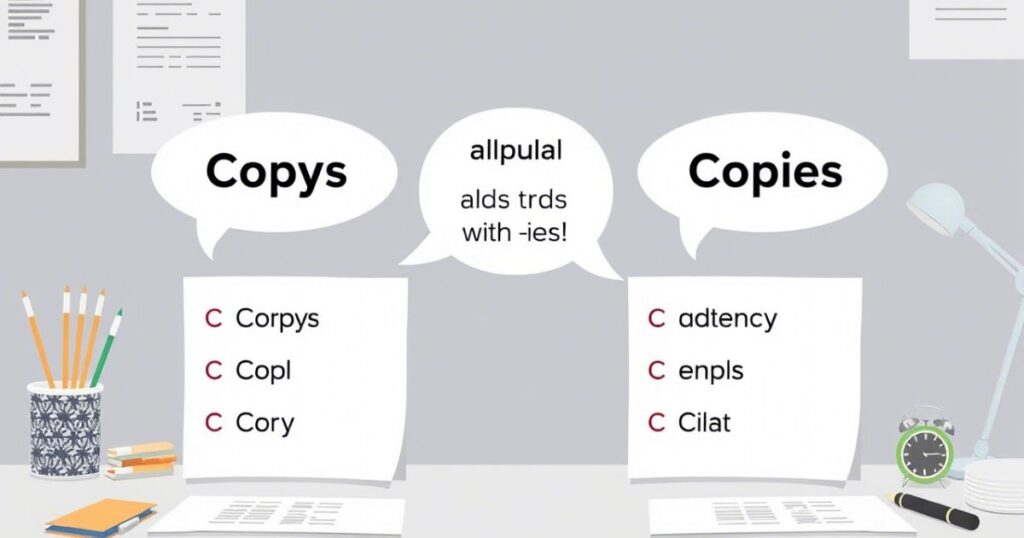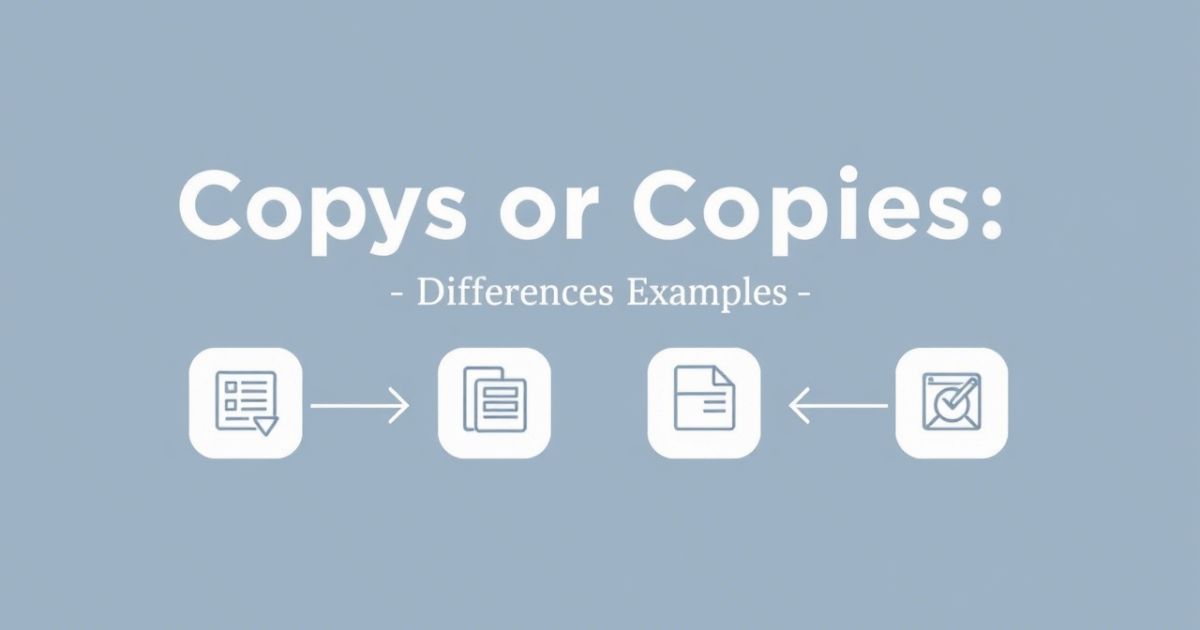When it comes to the words “Copys or Copies”, many people get confused. The correct plural form is “copies”, not “copys”. It’s important to know the difference between “copy’s” and “copies” too. “Copy’s” is a possessive form, while “copies” is the plural form. So, when you want to talk about more than one copy, you should always use “copies”. Using “copys” is a common mistake, but it’s not correct in English.
The key is understanding when to use “copies” versus “copys”. Always remember that for plural, it’s “copies or copys“, not “copys”. When in doubt, just think: if you’re referring to one, it’s “copy”, and for more than one, it’s “copies”. So, next time, make sure to use “copies” instead of “copys” in your writing.
Real World Implications of Correct Usage

The proper use of “copys” and “copies” has far-reaching implications in real-world communication. From professional business settings to academic environments, writing clearly and correctly is essential for making a positive impression. Even a small error, like using “copys” when you should say “copies or copys,” can undermine the clarity of your message and cause you to lose credibility with your readers.
For instance, imagine you are preparing an important business proposal and need to request “copies” of certain documents. If you mistakenly write “copys” instead, your request may appear careless and unprofessional. In a business setting where precision is key, such an error can impact your overall image.
On the other hand, using “copies or copys“ correctly shows that you’ve paid attention to detail, enhancing the professionalism of your writing. Whether you’re drafting an email, writing a report, or preparing marketing materials, ensuring correct grammar and spelling plays a key role in presenting yourself as competent and authoritative.
In addition to professional communication, the importance of using “Copys or Copies” correctly extends to academic writing, where clear and precise language is essential. In research papers, essays, or formal reports, errors like “copys” instead of “copies” could negatively impact the reader’s perception of your work. If you want to ensure that your academic writing is taken seriously, mastering the proper usage of these terms is crucial.
Which One is Correct: Copys or Copies? What is the Difference Between Them?
The confusion between “copys” and “copies or copys“ is a result of a misunderstanding of English grammar rules. In many cases, English follows a simple rule for pluralization: when a word ends in “y”, you change the “y” to “ies” to form the plural. However, “copy” is an exception to this rule, and its plural form is “copy’s or copies,” not “copys.”
So, why isn’t “copys” correct? It all comes down to how English handles pluralization. According to standard grammar rules, when a noun ends in a consonant followed by “y” (like “copy”), the correct plural form is made by changing the “y” to “ies.”
Here’s a breakdown of this rule:
- Correct: Copies
- Incorrect: Copys
This pattern is consistent with other words that end in “y” and are preceded by a consonant. For example, consider these common nouns:
- Baby : Babies
- City : Cities
- Party : Parties
- Copy : Copies
As you can see, “copy” follows the same pattern as “baby,” “city,” and “party.” It’s essential to remember that “copys” is never a valid form in English grammar.
A Deeper Look at the Grammatical Rule
To better understand why “Copys or Copies” is the correct plural form, let’s examine the general rule for pluralizing nouns in English. When a word ends in a consonant and “y” (such as “copy”), the correct pluralization involves dropping the “y” and adding “ies.”
This rule applies to many similar words:
- Fly : Flies
- Sky : Skies
- Guy : Guys
- Copy : Copies
However, when a word ends in a vowel plus “y”, the plural form is simply “ys”, without changing the “y”. For example:
- Boy : Boys
- Toy : Toys
- Ray : Rays
The distinction between consonant + “y” and vowel + “y” is key to understanding how to form plurals correctly in English. So, when pluralizing “copy”, remember to replace the “y” with “ies” to create “copies.”
Common Mistakes of Copys or Copies
Using “copys” instead of “Copys or Copies” is one of the most common mistakes that English speakers make. While it may seem like a small error, it’s easy to overlook, especially when typing quickly or in informal writing. However, whether you’re drafting a formal letter, composing an email, or writing an academic paper, “copys” is never the right choice.
Let’s look at a few examples of how this mistake might appear in everyday writing:
- Incorrect: Can you send me three copys of the document? Correct: Can you send me three copies of the document?
- Incorrect: The copys of the report are ready for review. Correct: The copies of the report are ready for review.
- Incorrect: I need several copys of the presentation for the meeting. Correct: I need several copies of the presentation for the meeting.
Notice how in each of these examples, the use of “copys” is clearly incorrect, while “copies” is the proper choice. The key takeaway here is that “copy’s or copies” is the only correct form when you’re referring to multiple versions of something.
The Importance of Correct Grammar in Professional Writing
In professional writing, such as business emails, reports, presentations, and proposals, attention to detail is crucial. Using incorrect forms like “copys” can make your work appear rushed or careless. Even if your content is solid, small errors can detract from the overall impression you make.
Consider this example in a business email:
- Incorrect: Please send me the copys of the documents by tomorrow.
- Correct: Please send me the copies of the documents by tomorrow.
The first sentence might be seen as a minor mistake, but it could raise questions about the writer’s attention to detail. A more polished approach, using the correct form “copies,” will convey professionalism and accuracy. In any business or professional setting, clear and correct communication is key to making a positive impact.
Related Guide:
What Does Counting Your Days Mean? My 2025 Research And Update
Definition and Usage of Copys or Copies
Let’s dive into the definition and proper usage of “copys” and “copies” in more detail, starting with the noun form.
“Copys” as a Noun
The word “copys” is incorrect as a noun. When pluralizing “copy,” the proper form is always “copies.” A “copy” refers to a reproduction or duplicate of an original document, file, image, or piece of information. Whether you’re talking about physical or digital copies, the plural form is always “copies.”
For example:
- Correct: I need five copies of this report for the meeting.
- Incorrect: I need five copys of this report for the meeting.
In this case, “copies” refers to multiple duplicates of the report.
“Copys” as a Verb
Similarly, when “copy” is used as a verb, it refers to the action of making a duplicate of something. The verb “copy” never takes the form “copys” in the present tense. Instead, it conjugates to “copy’s or copies“ when used with a third-person singular subject.
For example:
- Correct: She copies the data to the backup drive every night.
- Incorrect: She copys the data to the backup drive every night.
How to Remember the Correct Usage of “Copys” or “Copies”

If you find yourself getting confused between “copys” and “Copys or Copies,” there are a few simple tricks to help you remember:
- Think of the “y” to “ies” rule: Just like “baby” becomes “babies,” “copy” becomes “copies.”
- Use a spell checker: If you’re unsure, most modern word processors and email platforms will flag “copys” as a spelling error. You can quickly check and correct the mistake by using “copies.”
- Practice with examples: The more you write and use the word “copy,” the easier it will be to remember that the plural form is “copies.” Try creating your own examples to reinforce the correct usage.
- Review common words: Many other words that end in “y” follow the same rule. Keep a list of these words handy for reference, such as party : parties, city : cities, and baby : babies.
By following these simple tricks, you’ll be able to avoid the confusion between “copys” and “copies” and ensure that your writing is always clear and correct.
Understanding the Importance of Correct Plural Forms in Writing
Correctly using plural forms like “Copys or Copies” rather than “copys” is more than just a grammatical detail it speaks to the professionalism and clarity of your writing. Whether you’re preparing a report for work, a research paper, or crafting an email to a client, attention to detail in your language choices reflects your commitment to accuracy. This can have a big impact on how your communication is received. By consistently using proper grammar, like choosing “copies” over “copys,” you avoid unnecessary confusion and ensure that your message is clear and authoritative.
In professional settings, especially, clarity and precision are paramount. Mistakes like using “copys” instead of “copies” can give off the impression that you aren’t thorough, potentially undermining your credibility. When you take the time to ensure correct word usage, such as properly pluralizing “copy” to “copies,” it reinforces your image as a competent and reliable communicator. As a result, small errors though seemingly insignificant can play a major role in shaping the overall impression you make on colleagues, clients, or anyone you’re communicating with.
Simple Tips for Avoiding Common Grammar Mistakes

Even experienced writers sometimes slip up when it comes to tricky grammar rules, especially when it comes to pluralization. To avoid the mistake of writing “copys” instead of “copy’s or copies,” it helps to familiarize yourself with the basic pluralization rules in English. A useful tip is to remember that when a word ends with a consonant and “y,” the “y” changes to “ies” in the plural form. This rule applies to words like “copy” becoming “copies,” “city” becoming “cities,” and “baby” becoming “babies.” The more you practice these rules, the less likely you are to make this common mistake.
If you’re ever unsure whether you should use copy’s or copies simply take a moment to pause and double-check your grammar. Using a spell checker or grammar tool can be a quick way to catch errors before sending off important emails or documents. Also, reviewing examples of correct grammar in different contexts whether in books, articles, or academic papers can help you internalize proper usage. With a little awareness and practice, mastering these simple rules will ensure you never make the mistake of writing “copys” again.
FAQ’s
What is the correct form: Copys or Copies?
The correct form is copies. Copys is a common mistake, but copies is the plural form of copy.
Why do people confuse Copys or Copies?
Many people confuse Copys or Copie due to pronunciation. It’s easy to mix up the spelling, but the correct plural is copies.
Is copy’s the same as Copys or Copies?
No, copy’s is the possessive form, while copies is the plural. Copy’s shows ownership, but copies means more than one copy.
Can Copys or Copies be used interchangeably?
No, Copys or Copie cannot be used interchangeably. Always use copies for plural. Copys is incorrect in English.
How can I avoid mistakes with Copys or Copies?
To avoid mistakes, remember: copies is plural, and copys is incorrect. Always use copies when referring to more than one copy.
Conclusion
When it comes to Copys or Copies, the correct form is always copies. Copys is a common mistake, but it is never grammatically correct. The plural of copy is copies, and this should be used in all situations. Understanding this simple rule helps prevent confusion in writing.
Always remember, Copys or Copies refers to more than one copy, while copys is an incorrect form. The possessive form, such as copy’s, indicates ownership. To avoid mistakes, make sure to always use copies when referring to more than one copy. By mastering this rule, your writing will become clearer and more professional.

Zion Blaze is a dedicated administrator with 5 years of experience in managing operations, optimizing workflows, and ensuring efficiency. Skilled in leadership, problem-solving, and team coordination.

